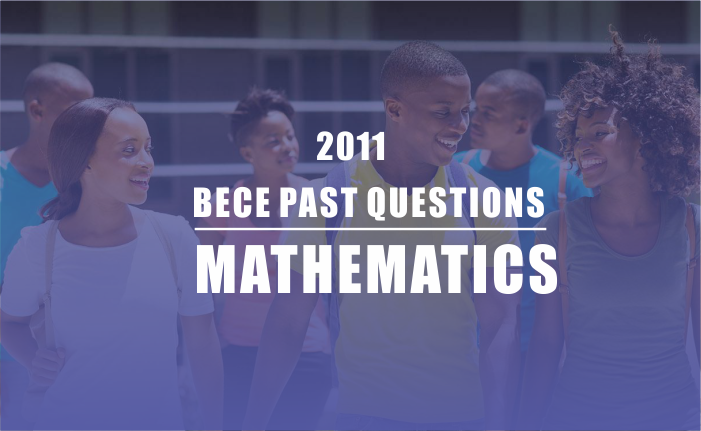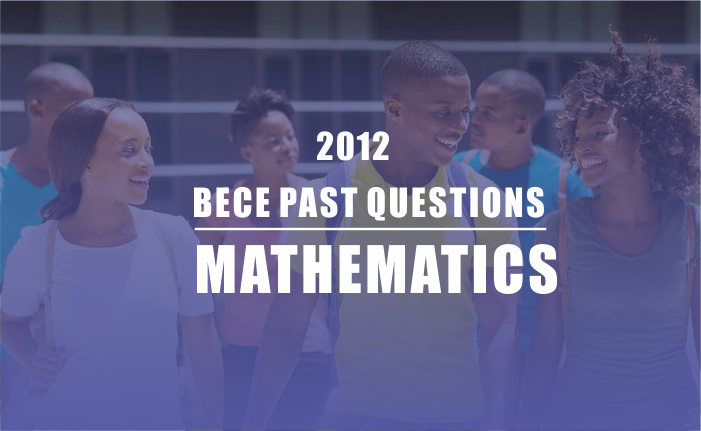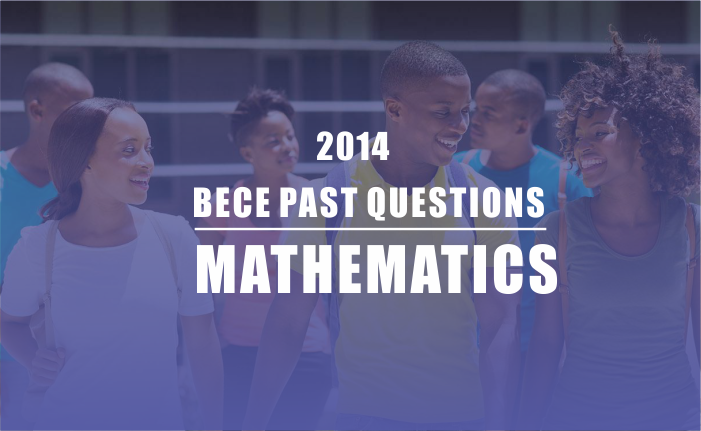Description
BECE 2017 Mathematics Questions and Answers
The Basic Education Certificate Examination, often known as the BECE, is an important test for students in West African countries, particularly Ghana and Nigeria, because it is used to determine whether or not they would continue their education to senior high school. An important factor in determining a student’s overall performance is the topic of mathematics, which is considered a core subject. In order to determine whether or not they would be permitted to continue their education and progress to senior high school, students in West African countries, particularly those in Ghana and Nigeria, are obliged to take the Basic Education Certificate Examination (BECE). This examination’s purpose is to establish whether or not they will be allowed to continue their education.
They are subjected to this procedure in order to ascertain whether or not they will be granted permission to continue their study. Following the conclusion of this evaluation, it is important for them to take this examination in order to determine whether or not they will be allowed to proceed with their studies. When it comes to determining a student’s overall performance, mathematics, which is considered to be a fundamental topic, is an essential component that carries a significant amount of weight.
Mathematical concepts are considered to be of basic importance, which is why this is the case. We are going to go over some of the most essential concepts and sample problems from the 2017 BECE Mathematics paper in order to aid students in their preparation for the upcoming BECE examinations. Our goal is to help students prepare for the upcoming examinations. This action will be taken with the purpose of offering assistance. In addition, we will provide these students with comments that are helpful as well as guidance that is based on our previous experiences.

Key Topics Covered in BECE 2017 Mathematics
The 2017 BECE Mathematics exam focused on various essential mathematical concepts taught at the junior high school level. These concepts include algebra, geometry, trigonometry, statistics, and basic arithmetic. Understanding these topics is crucial, as they frequently appear in subsequent exams. Here is a breakdown of some main topics and concepts that were tested in the 2017 BECE Mathematics paper:
- Algebraic Expressions
Algebra forms a foundational part of BECE Mathematics. Questions may involve simplifying expressions, solving for unknowns in equations, and working with inequalities. In 2017, students encountered questions that tested their understanding of variables and constants and required them to manipulate expressions to find solutions. - Geometry and Measurement
Geometry questions in BECE Mathematics often cover properties of shapes, perimeter, area, and volume. In 2017, students had to apply these principles to solve problems involving different geometrical shapes, including circles, rectangles, and triangles. Understanding the properties and formulas for each shape is essential for scoring well in this section. - Trigonometry Basics
Although advanced trigonometry may not be covered at the BECE level, basic trigonometric concepts such as ratios (sine, cosine, and tangent) are usually tested. In 2017, there were questions requiring students to understand right-angle triangles and apply basic trigonometric ratios to find unknown angles or sides. - Statistics and Probability
Statistics questions in the BECE typically involve mean, median, and mode calculations. In the 2017 exam, students needed to analyze data sets and calculate measures of central tendency, which are essential for making inferences in real-life situations. Probability questions were also included, requiring students to determine the likelihood of events based on given data. - Arithmetic Operations and Number Properties
Basic arithmetic operations, including addition, subtraction, multiplication, and division, are always essential. In the 2017 Mathematics paper, there were questions focused on fractions, decimals, percentages, and the properties of numbers, which students had to solve accurately.

Sample BECE 2017 Mathematics Questions and Answers
To provide further guidance, let’s look at some sample questions from the 2017 BECE Mathematics paper along with model answers.
Question 1: Algebraic Expressions
Question: Simplify the expression 2x+3y−x+4y2x + 3y – x + 4y2x+3y−x+4y.
Answer:
To simplify the expression, we combine like terms. For xxx, we have 2x−x=x2x – x = x2x−x=x. For yyy, we have 3y+4y=7y3y + 4y = 7y3y+4y=7y. Therefore, the simplified expression is: x+7yx + 7yx+7y
Question 2: Geometry – Area of a Circle
Question: Given a circle with a radius of 7 cm, calculate the area of the circle (use π=3.14\pi = 3.14π=3.14).
Answer:
The formula for the area of a circle is A=πr2A = \pi r^2A=πr2. Substituting the values:
A=3.14×72=3.14×49=153.86 cm2A = 3.14 \times 7^2 = 3.14 \times 49 = 153.86 \, \text{cm}^2A=3.14×72=3.14×49=153.86cm2Thus, the area of the circle is 153.86 cm².
Question 3: Trigonometry
Question: In a right triangle, one of the angles is 30°. If the length of the adjacent side is 10 cm, find the length of the hypotenuse.
Answer:
Using the cosine ratio for a right triangle, we have cos(30°)=adjacenthypotenuse\cos(30°) = \frac{\text{adjacent}}{\text{hypotenuse}}cos(30°)=hypotenuseadjacent. Substituting the values:
cos(30°)=10hypotenuse\cos(30°) = \frac{10}{\text{hypotenuse}}cos(30°)=hypotenuse10 Hypotenuse=10cos(30°)=100.866≈11.55 cm\text{Hypotenuse} = \frac{10}{\cos(30°)} = \frac{10}{0.866} \approx 11.55 \, \text{cm}Hypotenuse=cos(30°)10=0.86610≈11.55cmTherefore, the length of the hypotenuse is approximately 11.55 cm.
Question 4: Statistics – Mean Calculation
Question: Find the mean of the following data set: 4, 8, 10, 6, 12.
Answer:
To find the mean, add all the values and divide by the number of items in the data set:
Mean=4+8+10+6+125=405=8\text{Mean} = \frac{4 + 8 + 10 + 6 + 12}{5} = \frac{40}{5} = 8Mean=54+8+10+6+12=540=8The mean of the data set is 8.
Question 5: Probability
Question: A box contains 5 red balls, 3 blue balls, and 2 green balls. If one ball is randomly selected, what is the probability that it is a blue ball?
Answer:
The total number of balls is 5+3+2=105 + 3 + 2 = 105+3+2=10. The probability of picking a blue ball is given by:
Probability=Number of blue ballsTotal number of balls=310=0.3\text{Probability} = \frac{\text{Number of blue balls}}{\text{Total number of balls}} = \frac{3}{10} = 0.3Probability=Total number of ballsNumber of blue balls=103=0.3So, the probability of selecting a blue ball is 0.3.

Tips for Scoring High in BECE Mathematics
To excel in BECE Mathematics, here are some essential tips:
- Practice Past Questions
Practicing past questions, including the 2017 paper, helps familiarize students with the types of questions and exam format. It also helps identify common areas of difficulty. - Master Formulas and Theorems
Key formulas in geometry, algebra, and trigonometry should be memorized and practiced regularly, as they form the basis for solving complex problems. - Time Management
During the exam, managing time effectively is essential. Spend an appropriate amount of time on each question, and move on if a question proves too challenging initially, returning to it if time permits. - Understand Concepts, Not Just Procedures
Understanding the concepts behind mathematical processes allows for greater flexibility in solving different kinds of questions, even if they are framed differently. - Work on Accuracy
BECE Mathematics scoring is strict, so accuracy is vital. Practice mental arithmetic and double-check calculations to reduce careless mistakes.
Conclusion
The BECE 2017 Mathematics questions provide an excellent resource for students to understand exam expectations and the types of problems they may encounter. By focusing on key topics, practicing extensively, and following effective study techniques, students can build confidence and improve their performance in mathematics. For those preparing for the BECE, revisiting past questions and mastering fundamental concepts will be invaluable steps toward academic success.





Reviews
There are no reviews yet.